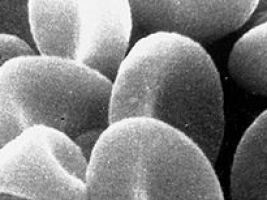
Patients with B-cell Non-Hodgkin lymphomas and advanced solid tumours have responded to a new drug that is being tested for the first time in humans in a phase I clinical trial.
Preliminary results from the trial were presented at the 26th EORTC-NCI-AACR Symposium on Molecular Targets and Cancer Therapeutics in Barcelona, Spain.
They show responses in four lymphoma patients who have failed numerous previous treatments and also in one patient with a cancer for which there is no approved medical treatment at all – a malignant rhabdoid tumour in the brain.
The drug, E7438 (also known as EPZ6438), inhibits the action of a histone methyltransferase (a type of enzyme) known as EZH2.
A mutant form of EZH2 is thought to be involved in the development of a number of cancers.
Dr Vincent Ribrag, head of haematology molecular therapeutics in the drug development department (DITEP), at the Gustave Roussy Cancer Campus, France, explains: “In many human cancers misregulated EZH2 enzyme activity results in misregulation of genes that control cell proliferation. Without these control mechanisms, cancer cells are free to grow rapidly. Targeting EZH2 is a novel approach under investigation in oncology. Preclinical work has shown that E7438 successfully targets EZH2 and causes cell death in a number of cancers.”
He told the Symposium: “In this study responses were seen in patients with lymphoma who were refractory to, or relapsed after, prior standard treatments as well as in a patient with a malignant disease for which there is no available standard medical treatment. This is the first time to our knowledge that a patient with this type of tumour has been treated with an EZH2 inhibitor and responded to treatment.”
The trial, which started at two centres in France in July 2013, has recruited 24 patients so far with a range of Non-Hodgkin lymphomas and advanced solid tumours, including one malignant rhabdoid tumour.
Aged between 24 and 84, the patients all had a poor prognosis after their cancers had failed to respond or had returned after several previous treatments.
For many of them this meant that they had no, or few, treatment options left.
They received E7438 orally at one of the five dose levels tested: 100, 200, 400, 800, or 1600 mg twice daily.
The researchers assessed the tumours every eight weeks and took blood and skin samples to assess the interaction of the drug with the body and its effect on the tumours.
Of ten patients with lymphoma who had tumour measurements taken whilst on treatment with E7438, one had a complete response (disappearance of all signs of cancer) and three had a partial response (tumour shrinkage) by the time of the EORTC-NCI-AACR Symposium.
Anti-tumour effects were seen at different dose levels.
In addition, one patient with a malignant rhabdoid tumour had a partial response in the group of 11 patients with advanced solid tumours.
Skin samples showed a decrease in skin cells expressing a protein called trimethylated H3K27 (H3K27Me3), which was related to exposure to the drug.
A decrease in H3K27Me3 shows that E7438 is biologically active and is inhibiting EZH2, since higher levels of EZH2 promote higher levels of H3K27Me3.
The researchers found that E7438 was well tolerated by most patients at all the dose levels up to 1600 mg twice a day.
The most common mild side-effects that were considered to be related to treatment with E7438 were weakness, decreased appetite and nausea.
The only severe side-effect considered to be related to the treatment was low platelet levels in one patient.
“The maximum tolerated dose was not reached because there was little toxicity observed,” Dr Ribrag said.
“Since we saw that the drug was active at doses lower than the maximum dose of 1600 mg twice a day, the dose used for the phase II trials planned for 2015 may be lower.”
Dr Kapil Dhingra, managing member of KAPital Consulting, LLC, USA, who is a member of the EORTC-NCI-AACR Symposium scientific committee, commented: “Epigenetic targets represent an important and relatively new focus for novel cancer therapeutics. Demonstration of efficacy in relapsed, refractory patients with lymphoma and a rare form of sarcoma constitutes an important clinical validation of EZH2 as a target. E7438 may, if its efficacy and safety is confirmed in larger cohorts of patients, provide a new personalised medical therapy for these patients.”
Non-Hodgkin lymphoma is the tenth most common cancer in the world, with an overall, five-year survival rate of 69%. There are multiple sub-types. The patients in this study had B-cell Non-Hodgkin lymphomas, including follicular lymphomas, diffuse large B cell lymphomas and marginal zone lymphoma.
Source: EORTC
We are an independent charity and are not backed by a large company or society. We raise every penny ourselves to improve the standards of cancer care through education. You can help us continue our work to address inequalities in cancer care by making a donation.
Any donation, however small, contributes directly towards the costs of creating and sharing free oncology education.
Together we can get better outcomes for patients by tackling global inequalities in access to the results of cancer research.
Thank you for your support.